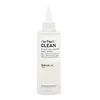What's inside
What's inside
 Key Ingredients
Key Ingredients

 Benefits
Benefits

 Concerns
Concerns

No concerns
 Ingredients Side-by-side
Ingredients Side-by-side

Water
Skin ConditioningDisodium Laureth Sulfosuccinate
CleansingGlycerin
Humectant1,2-Hexanediol
Skin ConditioningCoco-Glucoside
CleansingCentella Asiatica Extract
CleansingHouttuynia Cordata Extract
Skin ConditioningButylene Glycol
HumectantPentylene Glycol
Skin ConditioningSodium Cocoyl Apple Amino Acids
Skin ConditioningPanthenol
Skin ConditioningNiacinamide
SmoothingLactobacillus/Soybean Ferment Extract
Skin ConditioningLactobacillus/Rice Ferment
Skin ConditioningLactobacillus
Skin ConditioningSaccharomyces/Coix Lacryma-Jobi Ma-Yuen Seed Ferment Filtrate
Skin ConditioningSaccharomyces/Potato Extract Ferment Filtrate
HumectantPropanediol
SolventCitric Acid
BufferingCaprylyl Glycol
EmollientPolyquaternium-10
Rosmarinus Officinalis Leaf Oil
MaskingAllantoin
Skin ConditioningWater, Disodium Laureth Sulfosuccinate, Glycerin, 1,2-Hexanediol, Coco-Glucoside, Centella Asiatica Extract, Houttuynia Cordata Extract, Butylene Glycol, Pentylene Glycol, Sodium Cocoyl Apple Amino Acids, Panthenol, Niacinamide, Lactobacillus/Soybean Ferment Extract, Lactobacillus/Rice Ferment, Lactobacillus, Saccharomyces/Coix Lacryma-Jobi Ma-Yuen Seed Ferment Filtrate, Saccharomyces/Potato Extract Ferment Filtrate, Propanediol, Citric Acid, Caprylyl Glycol, Polyquaternium-10, Rosmarinus Officinalis Leaf Oil, Allantoin
Water
Skin ConditioningPEG-40 Hydrogenated Castor Oil
EmulsifyingAlcohol Denat.
AntimicrobialGlycerin
HumectantPropylene Glycol
HumectantSorbitol
HumectantVinegar
Menthol
MaskingSaccharomyces/Rice Ferment Filtrate
Skin ConditioningHydrolyzed Corn Protein
Skin ConditioningHydrolyzed Wheat Protein
Skin ConditioningHydrolyzed Soy Protein
HumectantPanax Ginseng Root Extract
EmollientLeuconostoc/Radish Root Ferment Filtrate
AntimicrobialShea Butter Ethyl Esters
EmollientSodium Hyaluronate
HumectantPentylene Glycol
Skin ConditioningButylene Glycol
HumectantXanthan Gum
EmulsifyingEthylhexylglycerin
Skin ConditioningDisodium EDTA
Sodium Hydroxide
BufferingPhenoxyethanol
PreservativeT-Butyl Alcohol
PerfumingParfum
MaskingLinalool
PerfumingWater, PEG-40 Hydrogenated Castor Oil, Alcohol Denat., Glycerin, Propylene Glycol, Sorbitol, Vinegar, Menthol, Saccharomyces/Rice Ferment Filtrate, Hydrolyzed Corn Protein, Hydrolyzed Wheat Protein, Hydrolyzed Soy Protein, Panax Ginseng Root Extract, Leuconostoc/Radish Root Ferment Filtrate, Shea Butter Ethyl Esters, Sodium Hyaluronate, Pentylene Glycol, Butylene Glycol, Xanthan Gum, Ethylhexylglycerin, Disodium EDTA, Sodium Hydroxide, Phenoxyethanol, T-Butyl Alcohol, Parfum, Linalool
 Reviews
Reviews

Ingredients Explained
These ingredients are found in both products.
Ingredients higher up in an ingredient list are typically present in a larger amount.
Butylene Glycol (or BG) is used within cosmetic products for a few different reasons:
Overall, Butylene Glycol is a safe and well-rounded ingredient that works well with other ingredients.
Though this ingredient works well with most skin types, some people with sensitive skin may experience a reaction such as allergic rashes, closed comedones, or itchiness.
Learn more about Butylene GlycolGlycerin is already naturally found in your skin. It helps moisturize and protect your skin.
A study from 2016 found glycerin to be more effective as a humectant than AHAs and hyaluronic acid.
As a humectant, it helps the skin stay hydrated by pulling moisture to your skin. The low molecular weight of glycerin allows it to pull moisture into the deeper layers of your skin.
Hydrated skin improves your skin barrier; Your skin barrier helps protect against irritants and bacteria.
Glycerin has also been found to have antimicrobial and antiviral properties. Due to these properties, glycerin is often used in wound and burn treatments.
In cosmetics, glycerin is usually derived from plants such as soybean or palm. However, it can also be sourced from animals, such as tallow or animal fat.
This ingredient is organic, colorless, odorless, and non-toxic.
Glycerin is the name for this ingredient in American English. British English uses Glycerol/Glycerine.
Learn more about GlycerinPentylene glycol is typically used within a product to thicken it. It also adds a smooth, soft, and moisturizing feel to the product. It is naturally found in plants such as sugar beets.
The hydrophilic trait of Pentylene Glycol makes it a humectant. As a humectant, Pentylene Glycol helps draw moisture from the air to your skin. This can help keep your skin hydrated.
This property also makes Pentylene Glycol a great texture enhancer. It can also help thicken or stabilize a product.
Pentylene Glycol also acts as a mild preservative and helps to keep a product microbe-free.
Some people may experience mild eye and skin irritation from Pentylene Glycol. We always recommend speaking with a professional about using this ingredient in your routine.
Pentylene Glycol has a low molecular weight and is part of the 1,2-glycol family.
Learn more about Pentylene GlycolWater. It's the most common cosmetic ingredient of all. You'll usually see it at the top of ingredient lists, meaning that it makes up the largest part of the product.
So why is it so popular? Water most often acts as a solvent - this means that it helps dissolve other ingredients into the formulation.
You'll also recognize water as that liquid we all need to stay alive. If you see this, drink a glass of water. Stay hydrated!
Learn more about Water